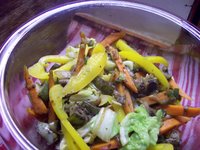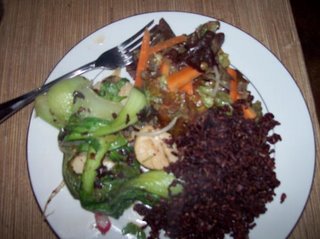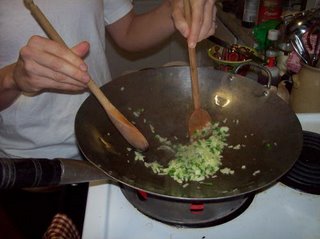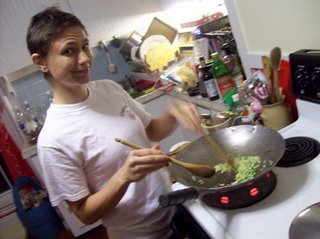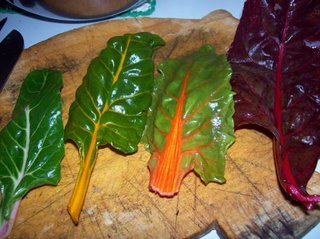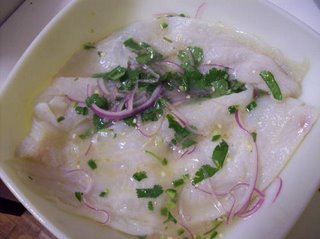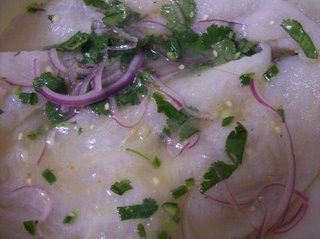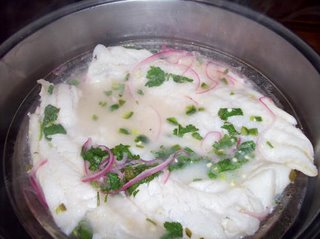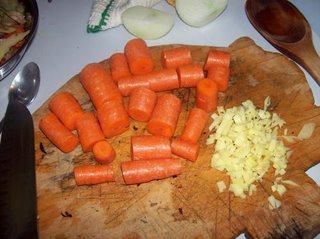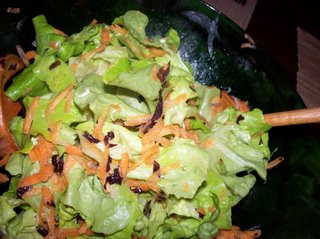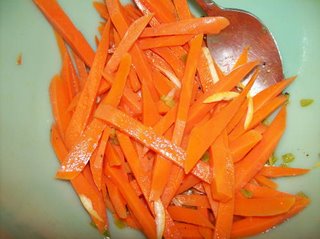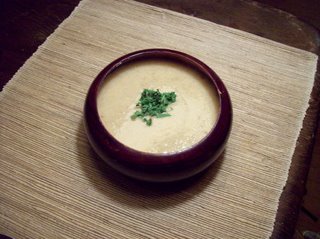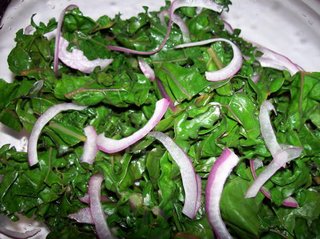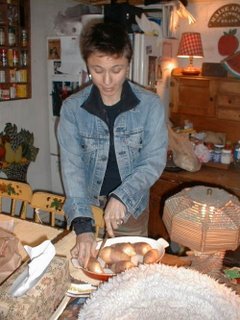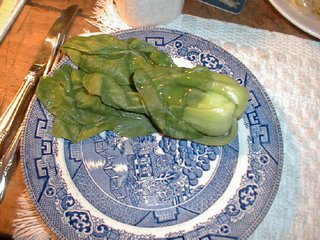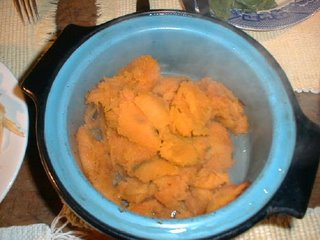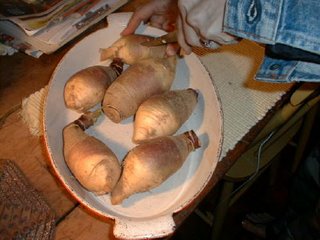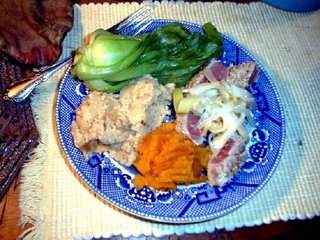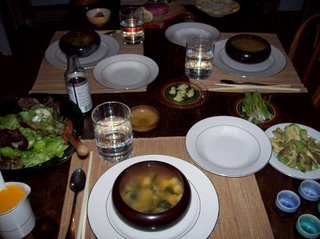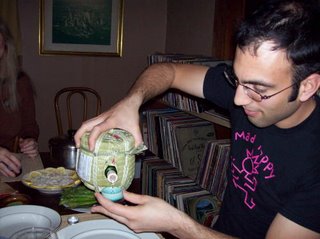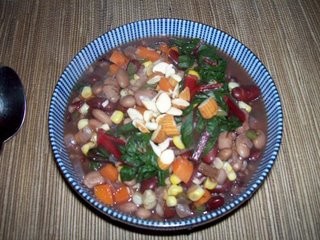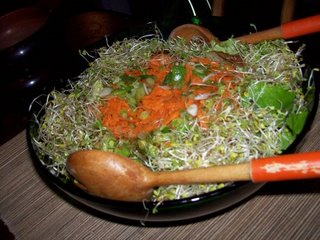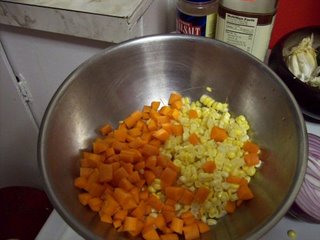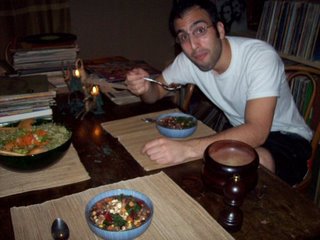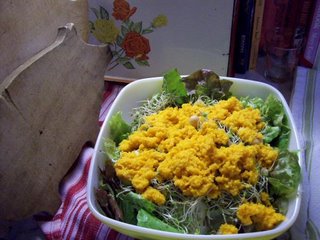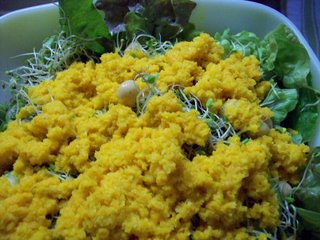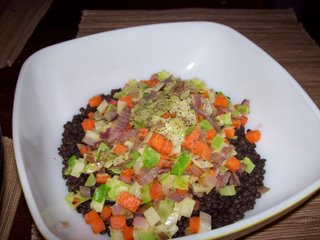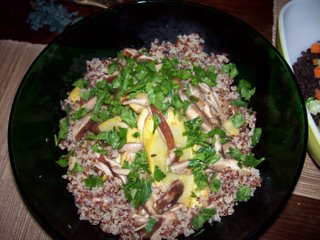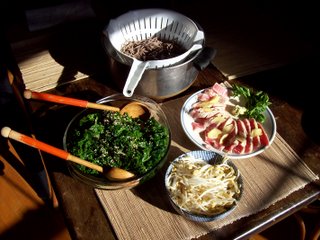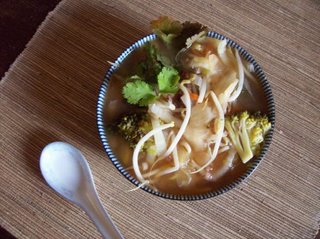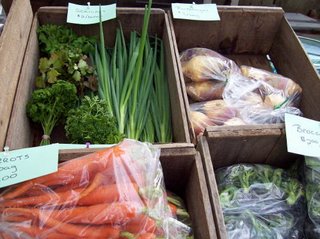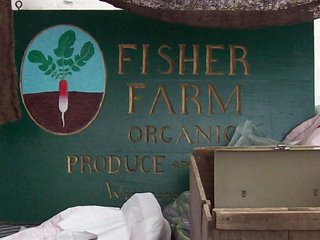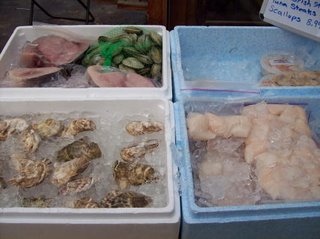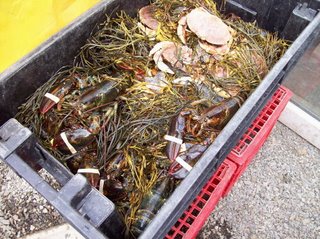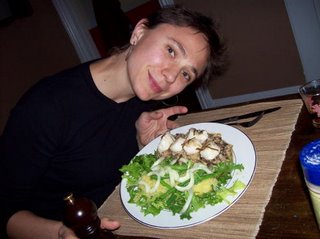
Scallop Dinner with Risotto style oat groats and wild rice accompanied by a crispy winter salad
RECIPES
Risotto style oat groats and wild rice
1 medium, finely chopped onion
1 tablespoon olive or other vegetable oil
1 ½ cup oat groats (whole oats)
½ cup wild rice
5 cups (give or take) stock
cook onion in oil on medium high until begins to brown
add oat groats and wild rice
stir and toast for a minute or two
slowly add liquid and continue to stir until grain has absorbed enough water to be fully cooked. This takes a long time with a lot of stirring and adding of liquid. I recommend multi tasking. For example, playing scrabble while taking turns with your adversaries/family/friend(s) adding liquid and stirring grain is a great way to accomplish two things at once.
Steamed citrus scallops
juice of two limes
juice of ½ large lemon
¾ cup white wine
pinch of salt
approximately 2 tablespoons thinly sliced red onion
several thinly chopped kaffer lime leaves*
12-14 sea scallops
pepper to taste
*if you can’t find these, don’t sweat it, just forge on without them
Mix citrus juices, ½ cup wine, salt, keffer lime leaves, onion and white wine in a bowl. Add scallops. Refrigerate for approximately ½ hour. Heat a pan on medium high heat, add scallops and marinade. Cook, covered, until scallops are done (1-2 minutes). Remove scallops with a slotted spoon. Reduce marinade, add more white wine and continue to reduce until you have a nice thick sauce.
Multi Layered Salad
½ head chicory or other curly green
1 large cucumber, peeled with seeds removed
large handful of green beans
small portion of a cooked spaghetti squash
Wash, dry and cut or tear into bit size pieces the chicory or other green. After the cucumber is peeled and the seeds removed, slice into ¼ inch slices. Blanch the green beans. Use a knife to make small slices in the squash. Bake whole spaghetti squash at 375˚ for about an hour until the squash gives a little. You might want to add a small amount of water to the baking dish to prevent burning. After squash has cooled for a while cut in half. Use spoon to remove seeds and then use fork to pull out the spaghetti like strands of the actual squash “meat.” When serving salad first place chicory or other green on plate, then squash, then green beans and then cucumber. Dress with vinaigrette. The layering provides a nice visual because the chicory or other green is a dark green, followed by the pale orange of the squash which provides a nice background for the dark green beans and then finally the pale cucumbers can be added and will stand out nicely.
Vinaigrette
1 part olive oil (1/4 cup or less)
1 ½ part vinegar (we used sherry vinegar)
1 crushed garlic clove
pinch of salt
1 table spoon rice syrup or other sweetener
Add all ingredients in a jar with lid or other favorite dressing vessel. Shake and spoon over salad on plate.
STORY:
After walking to the European Market yesterday, mom and I mad a trip to the health food store. I gathered as many gluten free grains as I could lay my hands on. My cart looked as though I must be preparing for a ten week snowed in retreat deep within the northern woods of Canada. But I’m just a grain addict.
For this evening’s meal, I decided to combine two of my purchases: whole oat groats and wild rice. The idea was to have some contrasting colors and contrasting flavors with the two grains. The oats are a nutty brown color and the wild rice is black. Since both grains take a very long time to cook, I figured that I could cook them together and they would finish at about the same time. The other bit of inspiration I had for this evening was to cook the grain in a risotto style fashion by toasting the grains in a pan with some oil and onion then slowly adding liquid while almost continually stirring to make a creamy, rich grain dish. It is a bit of a labor of love to cook grains this way. You have to be by the stove the entire time stirring and slowly adding liquid. But the creamy, rich texture is a nice treat once and a while. Tradition dictates that grated parmesan cheese is added at the end, but I don’t eat dairy and I think the grains have more of their own flavor without the extra ingredient. In order to pass the time in this risotto style adventure Mike and I played a game of scrabble while taking turns stirring and adding liquid. Mike got a bingo early on (a seven letter word with a 50 point bonus) and I felt as though my rack with the Z, Q, X and one vowel (not U!) was going to lead me into an embarrassing loss. But I stayed the course, got lucky a few times and came out about twenty points on top. Of course this victory was sandwiched between a devastating boggle loss the night before and a candle pin bowling defeat that was yet to come later in the evening. But I digress. The stock I used for the grains was a fish stock prepared by bringing a piece of Kombu sea vegetable to a boil in 5 or 6 cups of water then turning off the heat and adding about ½ a cup of shaved bonito flakes. Bonito flakes are the shavings from mackerel that has been smoked and dried. I saw a package of these bonito flakes in the store last week and was reminded of late nigh insomniac viewings of Iron Chef back in 1997 before the show was popular and it only aired at 1 in the morning. The flavor of the bonito flakes is strong and very smoky. In retrospect, I should have opted for a vegetable stock because Mike, in particular, does not like a smoky flavor. And the stock did, in fact turn out to be a bit overbearing. But so it goes when trying out new things and getting nostalgic for 1997…
To cook the spaghetti squash I pierced it with a small knife and baked it whole at 375˚ for about an hour. I placed a little water in the baking dish to prevent any burning. I’ve served spaghetti squash before, but it’s not as popular as buttercup or butternut because it’s not sweet and luscious. But I am unwilling to give up on such a cool food. You literally pull strands of noodle like squash out with a fork. It’s amazing to watch. So the question last night was, how can I serve it so that it will be tasty? I think the answer, in general, is to capitalize on the fact that the squash comes out fairly crunchy and it will readily absorb whatever flavor is added to it. I tried it last night as an addition to a salad. I think this is a great way to make salads in the fall and early winter seem more “in season”. The other component of the salad for this evening I was pretty excited about is a bunch of Hickory that was at the grocery store this past Thursday. Normally our local stores carry only the usual red leaf, green, leaf, iceberg and romaine varieties. But every once and a while something unexpected happens in the produce isle. There was no way I could pass it up. Chicory is slightly bitter and very crunchy. Just like salty, sour, and sweet, bitter is an important taste for our palate. It can be a little intimidating to cook bitter things if you’re not used to it. The first time I tried to cook dandelion greens, for example, I had to toss them. But trying out new foods is a great adventure and I like the challenge of trying to match taste and discover ways to serve unfamiliar tastes. Back to the salad. In the refrigerator I found a bunch of green beans I had purchased earlier in the week that was too small a serving and too past their prime to be the centerpiece of a dish, but once blanched and cooled in some ice water, they were a beautiful dark green and wonderfully crispy. Finally I peeled, cut lengthwise and removed the seeds from a cucumber. Cucumber has such a distinct flavor and provides a watery crunch that is great in all sorts of dishes. What I’m most happy about with this particular salad, however, is the layering of the colors and different shapes. This is how I assembled the salads directly on each plate. First the curly green chicory that included a variety of dark and light greens. Second the pale yellow/orange of the squash that remained slightly crispy. Third the dark green beans with a serious snap. Last the pale green cucumbers that were crunchy but offered little resistance to chewing. All in all it was a satisfying salad to look at and to eat. The dressing was a simple vinaigrette made from a crushed garlic clove, sherry vinegar, olive oil, a pinch of salt and a little rice syrup. I use rice syrup as a sweetener because it isn’t very sweet, it is made from brown rice and because it is not refined like sugar. But for a salad like this, just pick your favorite, simple, fairly plain vinaigrette with no spices.
When thinking about the scallops I immediately assumed that I would pan sear them because that’s what I like to do with scallops. But recently I’ve been trying to do things differently so I can learn more about cooking. So I decided to try to steam them in something yummy then reduce the marinade to make a sauce. During the afore mentioned trip to the heath food store I noticed some keffer lime leaves in one of the refrigerators. These leaves are used in Thai cooking frequently and, once again, I can’t pass up an opportunity to try something that might only be transiently in stock. The leaves have a very strong flavor and are usually chopped like other herb intp thin strips. To prepare the marinade I used the juice of two limes and ½ of a large lemon. I added about a half a cup of white wine. I would have used miren which is rice cooking wine, but the only brand they had at the grocery store included added sugar and I would prefer to use an inexpensive white wine over a sweetened product any day. I also added some salt, the thinly chopped lime leaves and a small amount, maybe a tablespoon, of very thinly sliced red onion. If I were to make this marinade again I would increase the amount of onion and reduce the number of lime leaves to two or three. (I think I used about 5-8 lime leaves this time which was a bit overpowering!) I placed the scallops, about 14 or so, in the marinade and let the combination it sit in the fridge until the grains were done. One of the great things about citrus is its’ ability to “cook” proteins. When proteins cook they get denatured, which is a chemical change that takes place due to the addition of heat. When you add something acidic like lime or lemon juice to a protein rich food, the proteins will also denature and “cook.” This is how ceviche, that delectable Spanish dish, is prepared. I’ve actually never made ceviche, but I think I’ve found a project for next week. My old roommate prepared it once and from what I understand, making ceviche a long process. What all this means for my scallops is that they had already begun to “cook” in the fridge and they were extra juicy and tender. To cook them over the stove, I placed a pan on medium high heat, added the scallops plus marinade and covered for about a minute. The scallops began to look like they were cooked, but to test I removed one, cut it in half, looked to make sure it was still a little translucent in the middle and, of course, tasted it. Perfect! I prefer my scallops just a little shy of cooked in the very center. But how you like your scallops is up to you. Just keep in mind that they will continue to cook a little even after you remove them from the heat. I took mine out of the pan with a slotted spoon and then began to reduce the liquid left in the pan. I added a little less than half a cup of wine and kept stirring and reducing until I had a nice syrupy sauce. I then made up the plates with the salad on one side and the scallops placed on a bed of the grains on the other side. I drizzled a little sauce over the top of the scallops and served.
Main Ideas:
I wanted a slow cooked vegetable (the squash) with some not-so-cooked or raw veggies (the chicory, green beans and cucumber).
I wanted something creamy (the risotto style grains) with something tangy (the salad dressing)
I also wanted to balance the hearty, creamy grains with the citrus-sweet scallops. I’m really glad that I didn’t pan fry the scallops so that the salad was the only crispy texture.
I wanted to have two different color grains which is not only nutritionally beneficial, but is very pleasing to the eye and more fun to eat.
I’m pretty happy with this meal. As I mentioned previously, I would not use a bonito based broth to cook the grains in the future. I would probably use a vegetable based broth or even just plain water. I might cook the grains like usual by covering them with twice the volume of water, bringing to a boil, then reducing to a simmer and cooking with the lid on until the water is absorbed. I would so this just so I wouldn’t have to attend to the stirring for an hour. I would also reduce the number of lime leaves. Speaking of which, the lime leaves are optional if you can’t find them. I would still try steaming scallops in a citrus marinade and then reducing the marinade in the pan for a tasty sauce. YUM!


